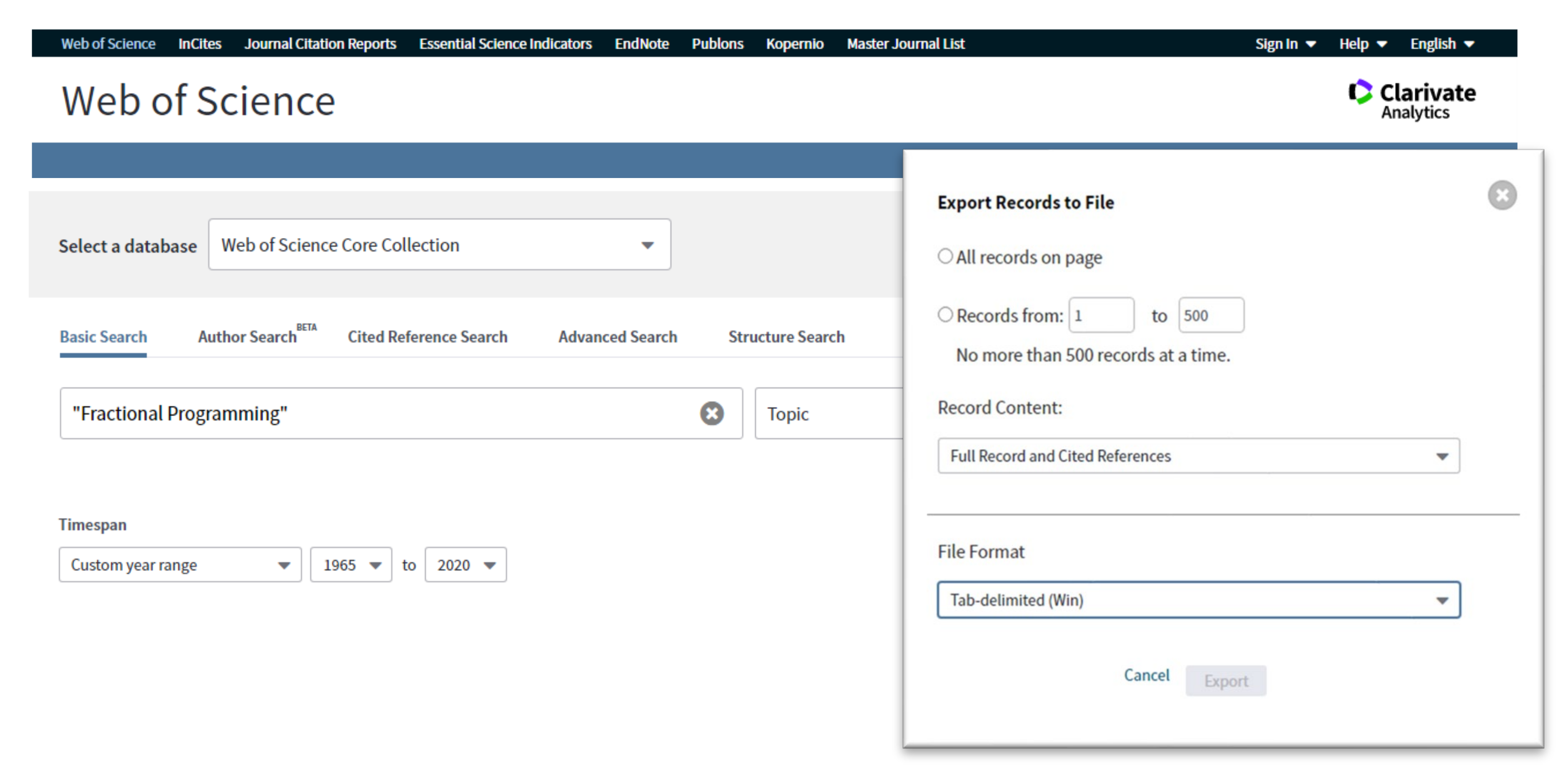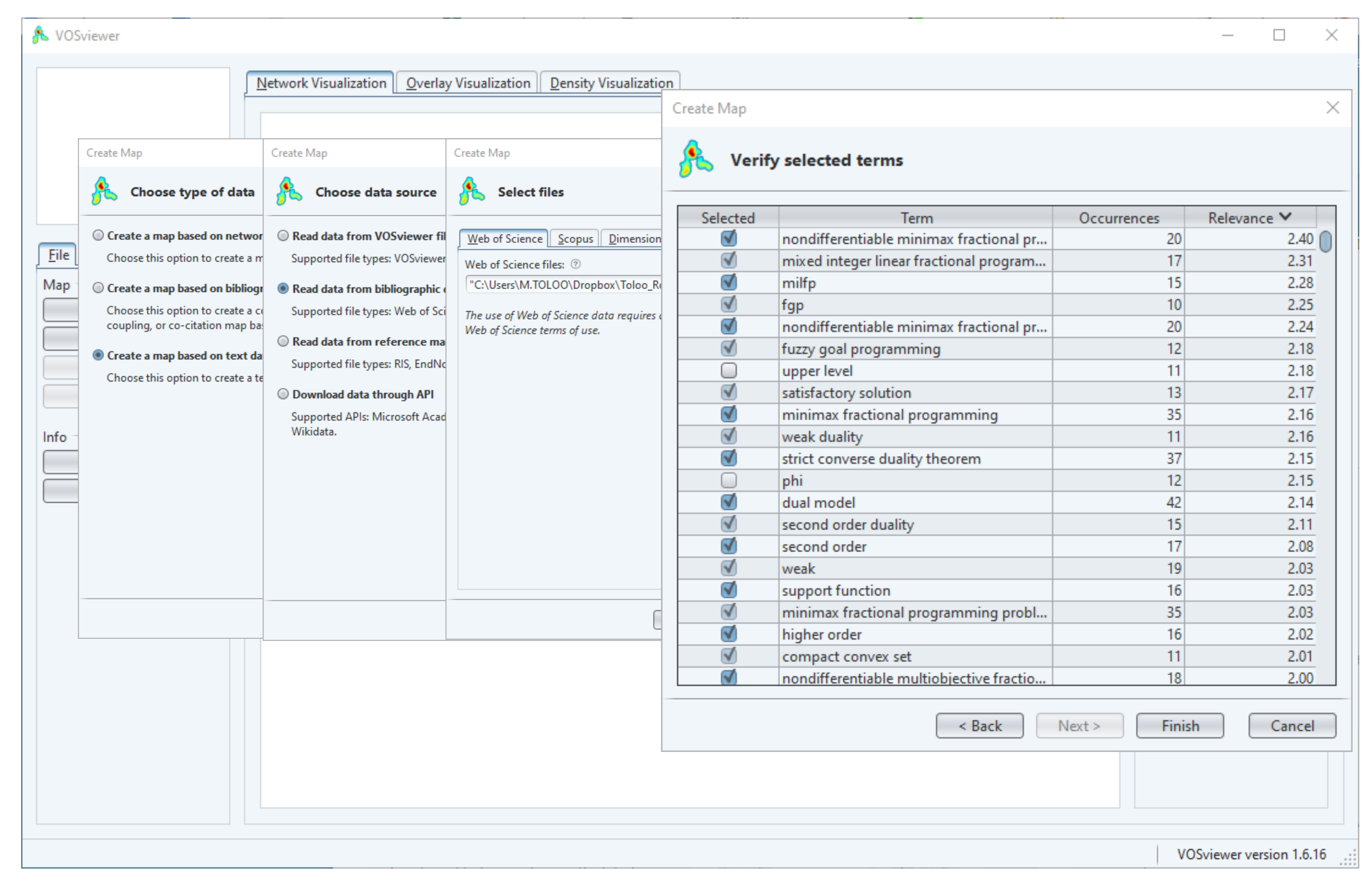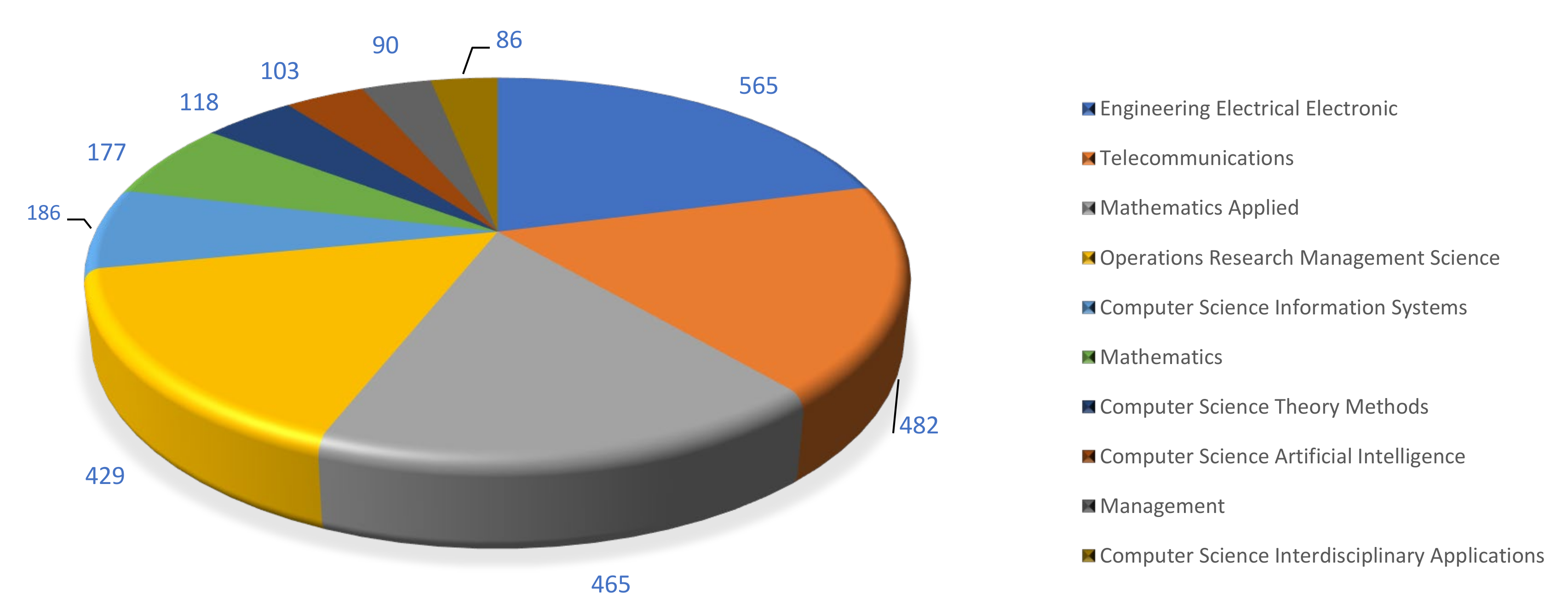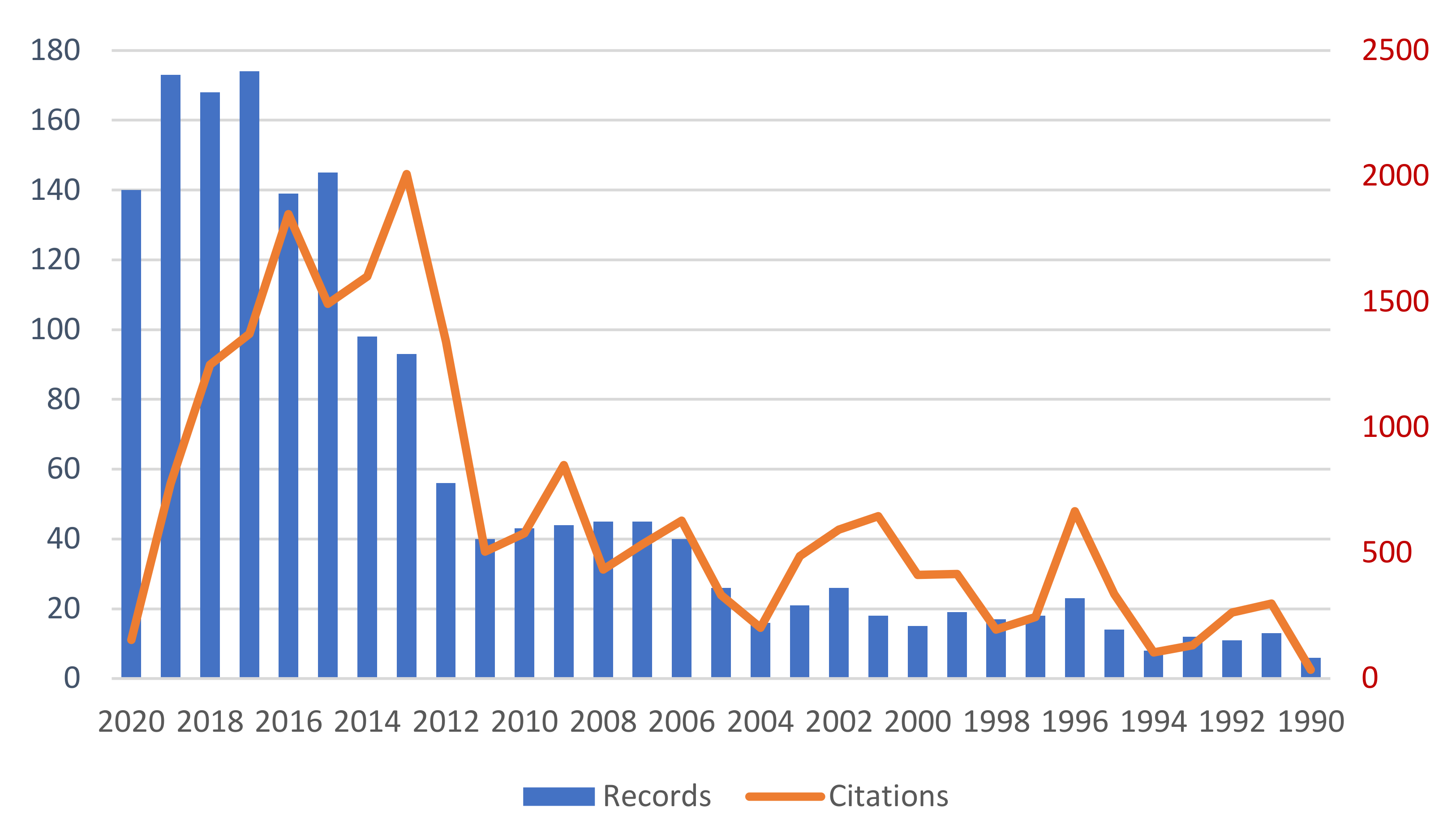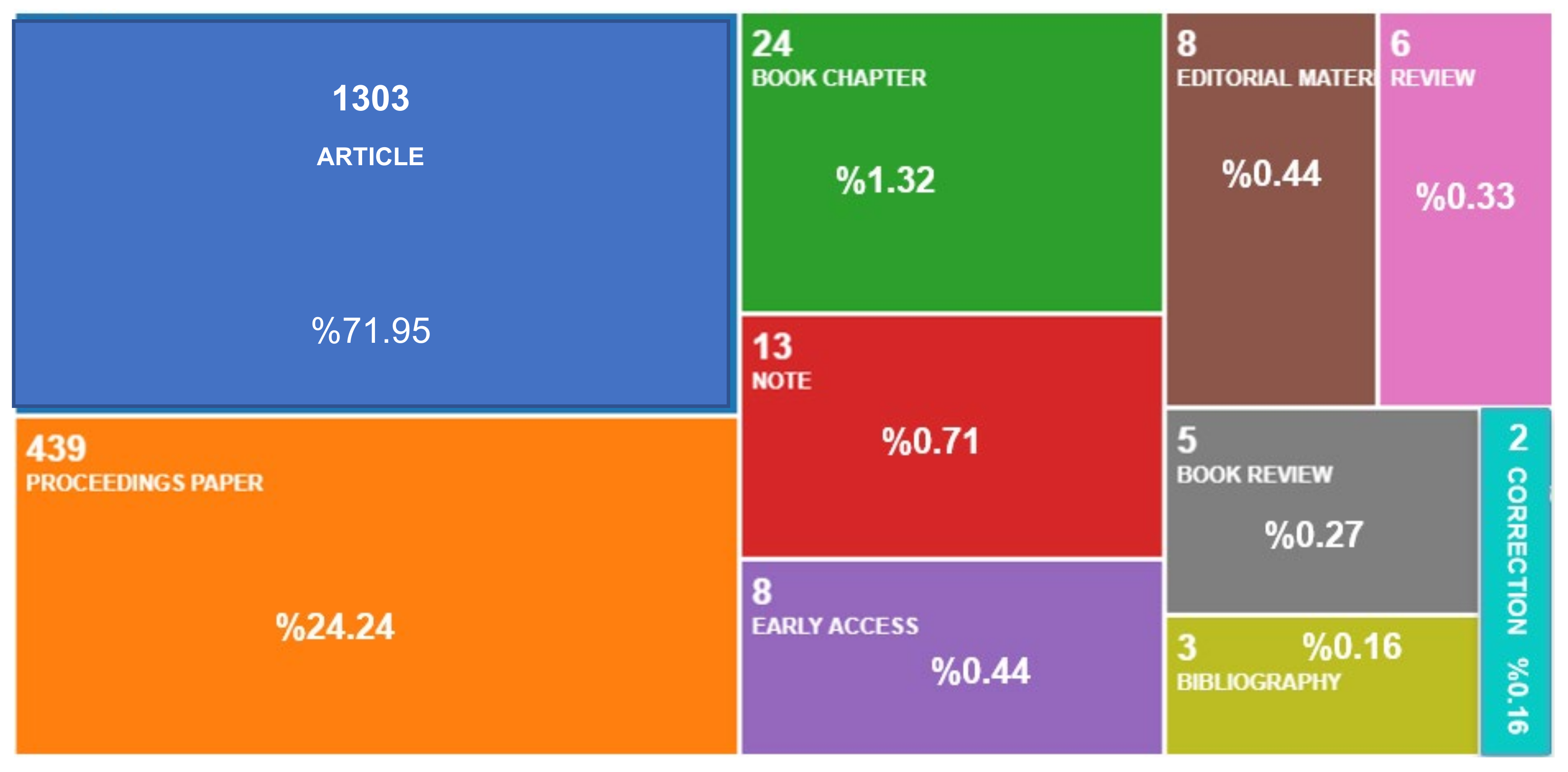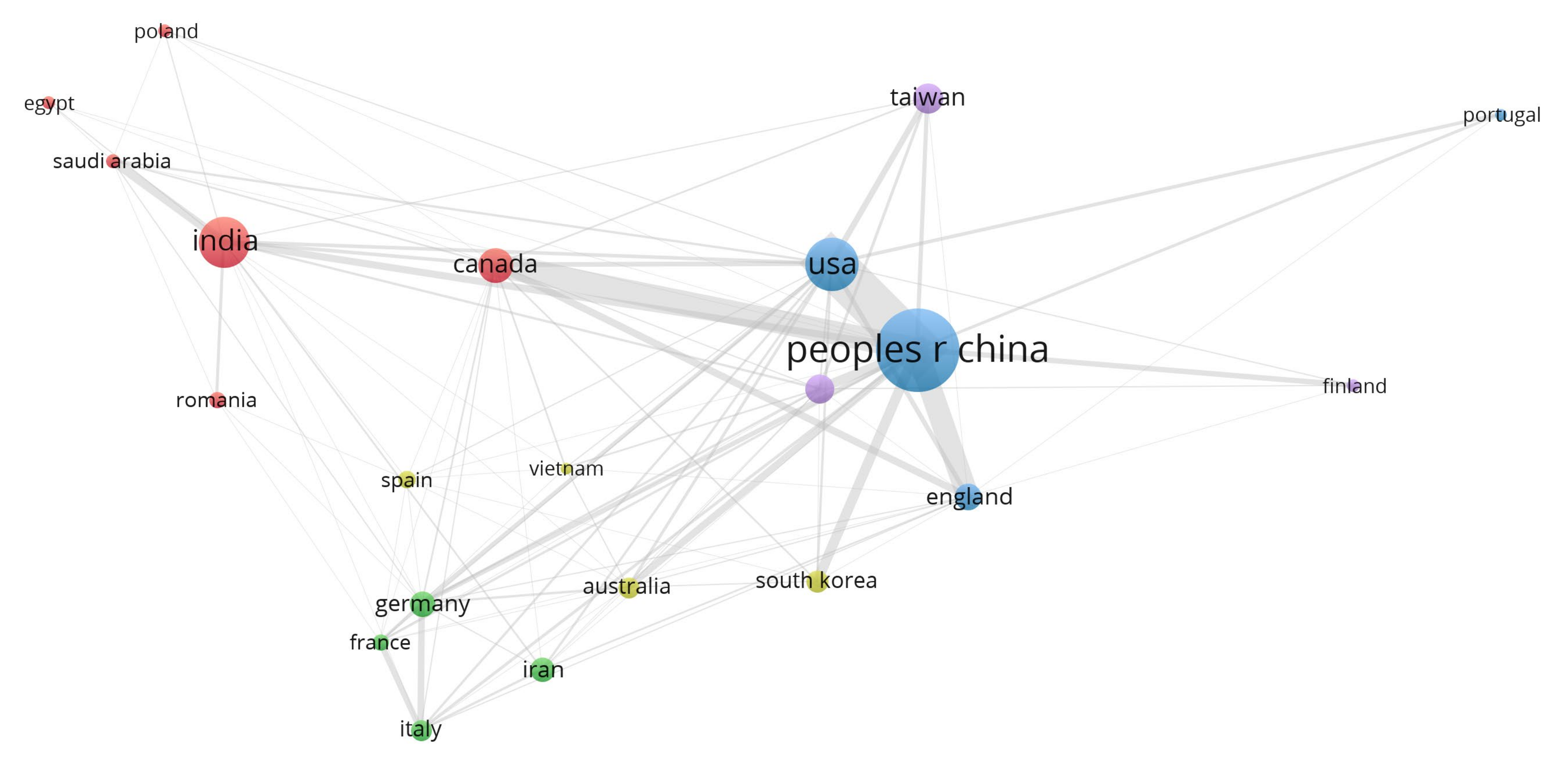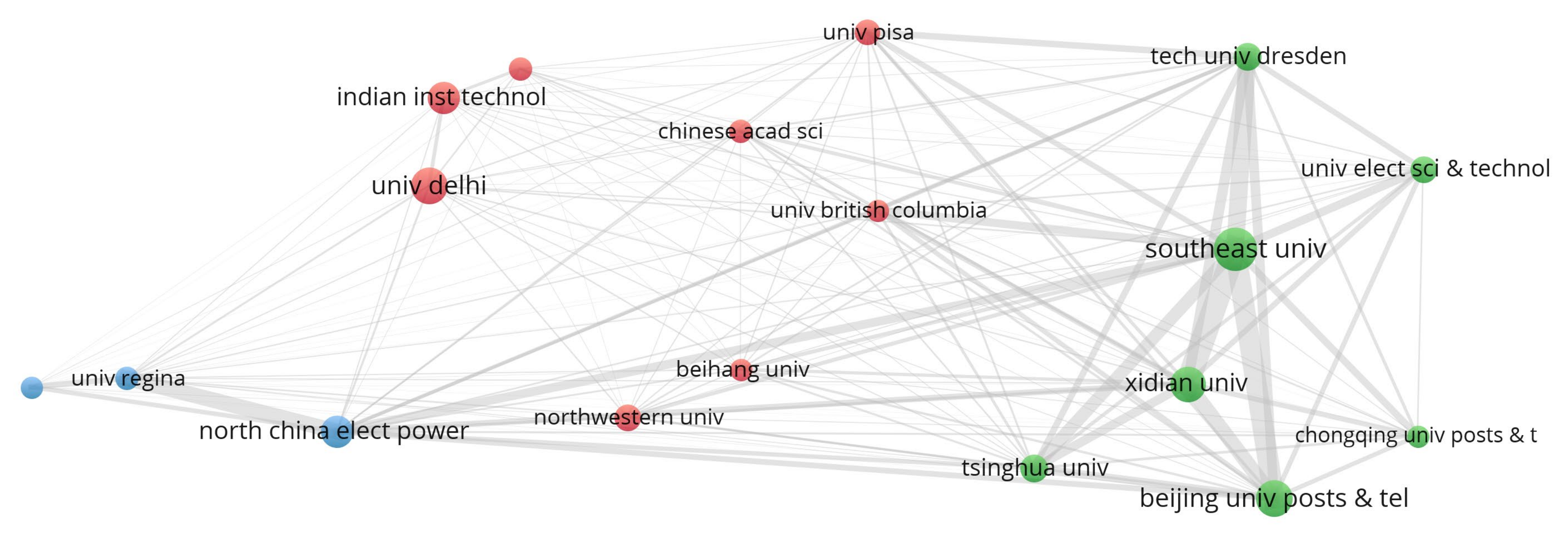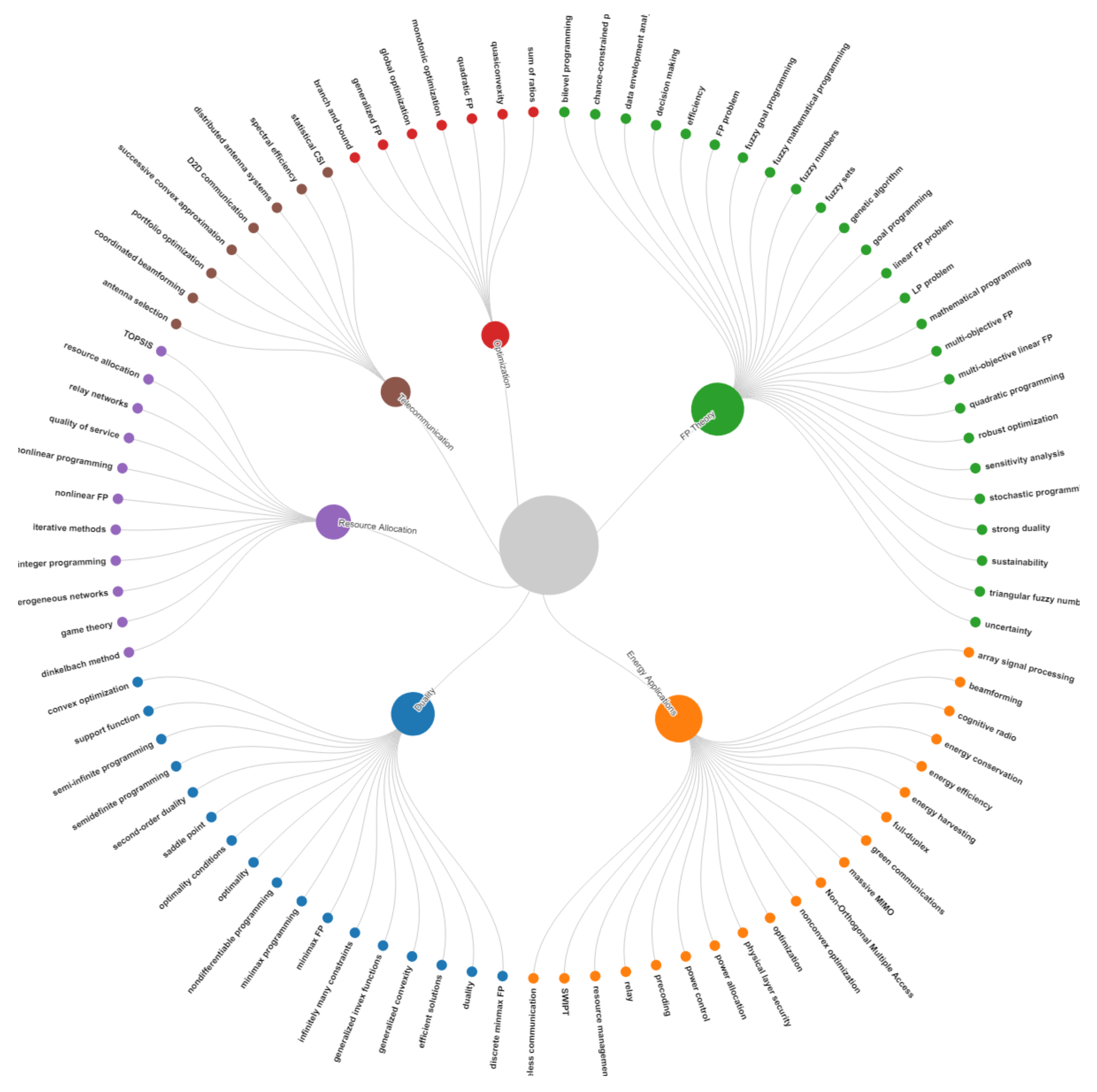1. Introduction
A constrained optimization problem aims at selecting the best (optimal) solution from all feasible (possible) solutions via the optimization (maximization/minimization) of an objective function in the presence of a set of constraints. If the objective function involves a ratio of two functions, the problem is called fractional programming (FP). The earliest known FP is probably the equilibrium model of Von Neumann [
1], where the objective function was the maximization of the growth rate (Frenk and Schaible) [
2]. Charnes and Cooper [
3] had the merit to pioneer a methodical study on FP, in which a linear FP is converted into a linear program through a variable transformation. The first collection of results pertaining to FP with a single ratio can be found in Schlette [
4]. Over two consecutive decades, two books, authored by Craven [
5] and Stancu-Minasian [
6] were published, each including a chapter on multi-ratio FP. The most recent bibliography on FP is by Stancu-Minasian [
7]. Studies on FP span many fields of economics, management science, information theory, optic and graph theory, communication, and computer science, etc. Recent applications include bank asset and liability management (Chuluunbaatar, Rentsen [
8]), cyber-security (Zheng et al. [
9]), power allocation (Dao and Kim, [
10]; He et al. [
11]), device-to-device communication (Hamdi et al. [
12], wireless communication (Ammar et al. [
13]; Sboui et al. [
14]), mobile edge computing (Ma et al. [
15]), optimization of resources for satellites (Ding et al. [
16]), oil refinery waste management (Zhumadillayeva et al. [
17], optimization of the operating modes of catalytic reforming units (Orazbayev et al. [
18]), data envelopment analysis (Toloo [
19]), and consequential life cycle optimization (Zhao and You, [
20]), to mention just a few studies. Per se, the spectrum of real-world applications of FP is significantly expanding, which renders it crucial that a review of related literature is conducted for a better understanding of the state-of-the-art, besides more informed identification of future research directions. From this perspective, a literature review provides scholars with the evidence to pursue prospective research venues (Grant, Booth [
21]).
The bibliometric approach is adopted for conducting the proposed literature review on FP. Such an option lies in the superior features of the bibliometric review, which (i) provides a quantitative analysis of written publications (ii) includes geographical and institutional aspects in the analysis, and (iii) examines the indicators of performance, including developments over time periods, subject domains or disciplines, and types of literature and authorship. For an in-depth discussion on the advantages of a bibliometric review, we refer the reader to Ellegaard and Wallin [
22].
Depending on the review’s purpose and approach, the most common types of literature reviews include the critical review, systematic (mapping) review, rapid review, narrative (traditional) review, scoping review, bibliography review, and the bibliometric review (Grant, Booth [
21]).
A systematic review uses repeatable analytical methods to collect, analyze, and synthesize secondary data to inform practice (Munn et al. [
23]). Systematic reviews formulate research questions that are broad or narrow in scope, and identify the data that are directly related to these questions. Very often, these reviews provide an exhaustive summary of current evidence that is relevant to a research question. In some cases, such reviews appraise research studies from a more critical perspective, and synthesize the findings qualitatively or quantitatively. Our initial search reveals that there are 216,274 systematic review records in the Web of Science (WoS), where the first paper is published by Alm [
24], and the top-cited paper is due to Stroup et al. [
25], with 12,610 citations.
A critical review is much more than a simple summary, as it involves an analysis, as well as an evaluation of the extant studies. It requires researchers to question the literature and to present their evaluation of the paper. Williams [
26] highlights that reading critically and analyzing all elements of a research paper are essential for a high-quality critical review. Indeed, all aspects of the text should be considered, including the structure, the methods, the reasons and evidence, and the conclusions. According to our preliminary investigation, there are currently 29,873 critical review records in the WoS databases; Whiteside, Walton [
27] and Podsakoff et al. [
28] are the first and the top-cited (29,448 citations) critical review papers, respectively.
A narrative review has been considered as an objective, critical, and comprehensive analysis of information in a particular field. Using this method provides some opportunities for researchers to establish a theoretical framework for their research. However, the latter review type is criticized for its lack of explicit intent to maximize the scope of the data collection or its analysis. Our cursory analysis points out that there are 14,691 narrative review papers in the WoS databases., the first one being published by Buell [
29]. Warburton et al. [
30] is the top-cited systematic review paper, with 3686 citations.
A rapid review is a form of literature synthesis that systematically reviews a part of the literature. It uses several design decisions and practical steps to reduce the time needed to identify, aggregate, and answer the research question. This type of review assesses what is already known for research, and critically evaluates the existing studies (Thomas et al. [
31]). Time limitation is the main weakness of a rapid review, which may lead to lower quality of the assessment, compared to other types of literature reviews. Our brief examination reveals that 1114 rapid review papers exist in the WoS. The first research is published by Settlage et al. [
32], whereas Brooks et al. [
33] is the top-cited paper, with 2869 citations.
A scoping review aims to search for the key concepts underpinning a field of study by mapping the language and data that surround these concepts, and by synthesizing the available evidence (Mays et al. [
34] and Arksey, O’Malley [
35]). A scoping review may often be a preliminary stage for a systematic review to determine the scope of coverage of a body of literature (Munn et al. [
23]) Our preliminary investigations show that 9932 scoping review papers are recorded in the WoS; Arksey [
36] and Peters et al. [
37] are, respectively, the first and the top-cited (1099 citations) papers.
A bibliographical review involves the analysis and explanation of all concepts, definitions, hypotheses, theoretical approaches, studies, and antecedents of a particular topic (Esquirol-Caussa et al. [
38]). A bibliographical review can support high-quality research by enabling the elaboration of the most appropriate research protocols, the integration of the best scientific evidence, and the best insights into the field of study (Eckert et al. [
39]). Our preparatory research demonstrates that there exist 873 bibliographic review papers. Geddes, James [
40] is the first paper under this category, whereas Zhang, Jiang [
41] is the top-cited paper, with 1374 citations.
A bibliometric review provides an overall structure of a particular research field by using quantitative (statistical) analysis and distributed architecture research/literature production (Persson et al. [
42]). In addition to a comprehensive review of the literature, it also considers other elements of the paper, such as the keywords, affiliation, title, and abstract, etc. Historically, the bibliometric review can be traced back to the 1920s (Hulme [
43]). In our initial search, we found 14,717 records on bibliometric review in the WoS databases, with Fairthorne [
44] as the first paper and Van Eck, Waltman [
45] holding a top number, with 2205 citations.
Figure 1 compares the aforementioned types of literature reviews from four different standpoints: speed, methodological details, risk of bias, and comprehensiveness.
As can be seen, bibliometric reviews can be conducted faster than the other types of reviews, especially systematic reviews, which are the most time demanding, which is certainly due to the advanced level of the methodological details that they may require. Moreover, bibliometric studies are the most comprehensive but the least likely to be biased, as opposed to narrative reviews, where fewer methods are generally covered.
For an in-depth discussion regarding the types of literature reviews, we refer the reader to Grant and Booth [
21].
Writing a literature review requires not only a good level of organization of the previous research (Shuttleworth [
46] and Rowley, Slack [
47]), but also an adequate choice of citation database. The proposed review of FP was conducted on the WoS. The choice for the WoS data source was due to the fact that (i) WoS is the largest and most trusted global citation database in the world, (ii) WoS is the most powerful research engine, providing the best-in-class publication and citation data for access and evaluation, and (iii) WoS collects and indexes high-quality research and creates the most comprehensive and complete citation network for every single record. The WoS data source is widely used for bibliometric reviews in many areas, including supply chain management (Govindan et al. [
48]), blockchain (Guo et al. [
49]), data envelopment analysis (Liu et al. [
50]), sustainable business models (Rosato at al. [
51]), energy metabolism (Tang et al. [
52]), Fenton oxidation (Usman, Ho [
53]), and uncertain group decision making (Wang et al. [
54]). The WoS website provides a navigation environment for a broad search across disparate resources, and enables the graphical representation of publication trends.
Among the data sources that are available for researchers to find, cite, link, access, and reuse academic publications, MathSciNet, CrossRef, Google Scholar, Scopus, and WoS are the most commonly used.
- (i)
MathSciNet is the most reliable source in the field of mathematics, and it originated in 1940 as the journal Mathematical Reviews. It is a bibliographic database created by the American Mathematical Society in 1996. MathSciNet encompasses almost 3.6 million items and over 2.3 million direct links to original articles from approximately 650 journals.
- (ii)
CrossRef, as the first data source, was established in 2000 by 12 publishers to simplify the process of linking to research on other publishers’ platforms. In recent years, CrossRef has also been used for citation analysis, digital object identification (DOI), and metadata search (Harzing [
55]).
- (iii)
Google Scholar is one of the academic projects by Google, founded in November 2004 as an index for academic literature full text or metadata search. The objective of Google Scholar was to bring Google search simplicity to the academic environment, but it has crawled the whole web by indexing any record with seemingly academic structure (Martín-Martín et al. [
56]). By using this inclusive approach, Google Scholar provides comprehensive coverage of scientific/academic documents without following the selective journal-based inclusion policies (Orduña-Malea et al. [
57]; Van Noorden [
58]; and Martín-Martín et al. [
59]). Google Scholar covers over 300 million records (Delgado López-Cózar et al. [
60]).
- (iv)
Scopus was launched in 2004 as Elsevier’s abstract and citation data source. It is one of the largest abstract and citation databases of publications (with over 1.7 billion cited references), covering nearly 41,462 titles from approximately 11,678 publishers. It covers over 76 million records with 3 million new items added every year (Baas et al. [
61]). Scopus is used by more than 3000 academic, government, and corporate institutions.
- (v)
WoS was established by the Institute for Scientific Information (ISI). Later, it transferred to Thomson Reuters, and is currently a part of Clarivate Analytics. WoS contains the following six main citation databases: (i) Science Citation Index (SCI), (ii) Social Sciences Citation Index (SSCI), (iii) Arts & Humanities Citation Index (AHCI), (iv) Emerging Sources Citation Index (ESCI), (v) Book Citation Index (BCI), and (vi) Conference Proceedings Citation Index (CPCI). It is the world’s first citation database, with over 1.9 billion cited references from over 171 million records, including 34,358 titles such as journals, books, and conference proceedings).
Under the WoS website, the wealth of data extracted for the bibliometric review leads indubitably to data processing and interpretation challenges (Solomon [
62]). To address these issues, visualization and mapping tools are the best suited for creating graphical representations of the data and enhancing users’ understanding. In this study, we employ the well-known VOSviewer software (Van Eck, Waltman [
63,
64,
65]), which allows for a comprehensive bibliometric analysis, including the co-citation of cited references, cited authors, and cited journals. VOSviewer is a Java-based program that is able to construct, visualize, and explore node-link maps based on bibliographic data (see Van Eck, Waltman [
63]). It focuses entirely on the visualization of bibliometric networks and provides distance-based visualizations rather than graph-based ones. Moreover, VOSviewer (i) possesses functionalities for zooming, scrolling, and searching, (ii) uses the “visualization of similarities” technique to construct a map, and (iii) provides bibliometric mapping and co-occurrence analysis on the title, abstract, and keywords. Furthermore, VOSviewer is an easy-to-use software and it is freely available to the bibliometric research community. Yet, VOSviewer cannot perform citation burst analysis. Such a deficiency has been tackled by using the application CiteSpace (Chen [
66,
67]), which enables us to show a temporal perspective on the publication and present citation burst.
There are other tools for creating bibliometric networks, but they cannot comprehensively cover all aspects of a bibliometric analysis, such as ‘bibliometric coupling’, ‘text mining’, and ‘co-occurrence analysis’. For instance, CitNetExplorer (van Eck and Waltman, [
65,
68]) and HistCite (Garfield [
69]) only focus on citation analysis.
The rest of this study is organized as follows.
Section 2 succinctly discusses the procedures employed for conducting the current study. In
Section 3, the extracted information is analyzed from multiple perspectives, and appropriate conclusions are drawn. Finally,
Section 4 concludes the paper.
4. Discussion
One of the most striking results is undoubtedly the fact that 94.2% of the publications related to FP appeared after 1990, corresponding with the upsurge of the digital revolution, and characterized by the adoption and proliferation of digital computing and communication technologies.
The synchrony of these events is better perceived through the disciplines where FP has been duly applied, with the top categories being Engineering Electrical Electronic (31.19%), Telecommunications (26.61%), and Applied Mathematics (25.67%). Regardless of the disparities noted among the proportions of publications within the different categories, these results reflect without a doubt the practical scope of FP as a sharp tool for modeling problems across several disciplines. As such, it is perhaps essential to disseminate these facts to the broader scientific community with the intention of opening new research horizons.
These results do not corroborate with the profile of the most productive scholar, You, FQ, who is indicated as being the most productive scholar, with 2.09% of the total publications and a ranking at the top of the list for the H index and >10 indicators, while originating from energy systems engineering. Although the category of “energy” has the least number of publication records (0.99%), it is very likely that such a ranking is due to the term “engineering”, which falls into the first position, along with Electrical and Electronic, along with 31.49% of the records. Nevertheless, the ranking patterns of the TC indicators, as well as the ratio TC/TP, seem to be more consistent with the overall results, revealing Ng, DWK, who belongs to the wireless communication field, as the lead.
No conflict can be found regarding the journals ranking for the TC indicators. Here, IEEE Transactions on Wireless Communications stands at the top of the list, emphasizing the outcomes of the research direction, which indicate that 57.8% of the reviewed records fall under the categories Engineering Electrical Electronic and Telecommunications.
In terms of the affiliations of the scholars who are actively working on FP, 7 out of the top 10 higher education institutions are universities that are located in China, though the Indian Institute of Technology System (IIT System, India) ranks first for the TP and TP% indicators, whereas the Dresden University of Technology leads the list based on the TC/TP indicator, which may suggest a wide degree of recognition for FP in this institution.
With regard to both the total number and the percentage of publications, China is the most prolific country, with 626 (34.56%) publications, followed by USA, with 286 (15.79%), and India with 271 (14.96). With six Asian countries/regions (China, India, Taiwan, Japan, Iran, and South Korea) listed among the top 10 most prolific countries, these results suggest that Asian universities are the most high performing within FP-related research.
The collaboration of FP Chinese scholars appears to be the strongest, with peers in USA, Canada, and England, but it is somehow weaker compared to other scholars from India, South Korea, Australia, and Taiwan. It is worth noting that the majority of the top scholars who have been identified as working on FP in USA, Canada, England, and Australia, are presumably from a Chinese background. Accordingly, the aforementioned collaborative pattern can be partly viewed from the migration perspectives of mainland Chinese students and scholars, besides the flow of migrants that followed the Hong Kong handover in 1997 (Gürüz [
83]).
5. Conclusions
This paper presented the first comprehensive review of the literature pertaining to FP. This review is unique, not only because it spans 55 years of FP-related research (1965–2020), but also because it was conducted through the bibliometric approach, a state-of-the-art methodology with proven superior features. Moreover, the importance of such a study stems from the emergence of FP as a piercing tool to model real-life problems that are likely to occur over a wide range of industries where the potential of FP still needs to be further explored. With 1811 records extracted from WoS data sources, we constructed a series of scientific maps of the publication numbers, countries, institutions, prolific authors, and journals. We also performed papers co-citation analysis, keywords co-occurrence analysis, and burst citation analysis on FP studies to provide a general overview of the field.
Our findings showed that China’s universities are leading the research in FP, as not only the most productive, but also the most superior in terms of the prolific universities that have been identified in the field, which counted 7 Chinese universities out of 10. Additionally, the strongest citation bursts place China at the top of the list from the high quality of the research perspective. Overall, universities from the USA and India succeed in the ranking, rendering the three countries as the main players in the FP research field.
With respect to the scientific journals, The European Journal of Operational Research (Eur. J. Oper. Res) has the most significant influence among the academic journals publishing FP research, followed by the the Journal of Optimization Theory and Applications (J. Optim. Theory. Appl.). Through thematic analysis, the extracted knowledge bases revealed that the research hotspots of FP studies focus on the FP Theory, Energy Application, Duality, Resource Allocation, Telecommunication, and Optimization. Finally, burst detection analysis revealed that more burst keywords emerged and changed more frequently during the period spanning 1990–2014, compared with the early stages of the research, suggesting that there were no steady research directions. However, the recent upsurge of keywords, such as “Multi-Objective FP”, “Energy Efficiency”, “Resource Allocation”, “Massive MIMO” (multiple-input and multiple-output), “SWIPT” (simultaneous wireless information and power transfer), and “Downlink” in FP studies undoubtedly unveils that there is a real proliferation of FP in applications pertaining to telecommunication and electrical engineering.

